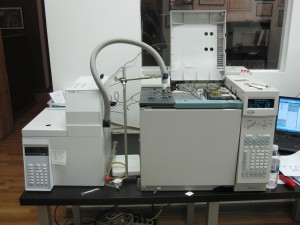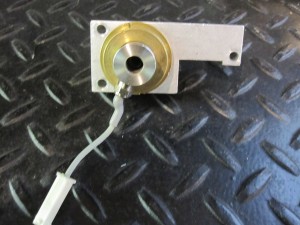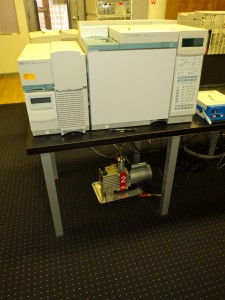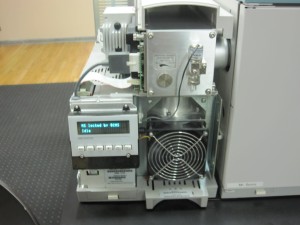First let’s remove the short hand and really write out what we are doing typically.
For blood analysis for EtOH, its proper technical name is Isothermal Static Headspace Gas Chromatography using Wall Coated Open Tubular Capillary Columns with Flame Ionization Detector. We just short name it to HS-GC-FID.

The technique is made up of distinct parts:
1. Isothermal (which just means same temperature throughout the run) (in other types of analysis including some Drugs of Abuse analysis there can be temperature programming legitimately)
2. Static (which just means every variable remains the same throughout) (in other types of analysis including some Drugs of Abuse analysis there can be other variable programming legitimately)
3. Headspace (the method of sample introduction) (greater information is outlined below)
4. Gas Chromatography (describes the matrix that the sample must be in so that it can be examined)(greater information is outlined below)
5. Wall Coated Open Tubular Capillary Columns (primary method of separation-major component of achieving the qualitative measure) (greater information is outlined below)
6. Flame Ionization Detector (the method of quantification)(greater information is outlined below)

In forensic science, controlled substances and illicit drugs (commonly referred to collectively “Drugs of Abuse” analysis), we typically use “GC-MS.” What we traditionally call simply “GC-MS” is best properly labeled as Gas Chromatography using Wall Coated Open Tubular Capillary Columns with a Mass Spectrometer acting as a detector.

It too has distinct parts:
1. Gas Chromatography (describes the matrix that the sample must be in so that it can be examined)(greater information is outlined below)
2. Wall Coated Open Tubular Capillary Columns (primary method of separation-major component of achieving the qualitative measure) (greater information is outlined below)
3. Mass Spectrometer (the method of qualitative confirmation and also quantification)(MS is used for determining masses of particles, for determining the elemental composition of a sample or molecule, and for elucidating the chemical structures of molecules. The MS principle consists of ionizing chemical compounds to generate charged molecules or molecule fragments and measurement of their mass-to-charge ratios. There are different types of MS such as Electron Impact and ElectroSpray)

The simple answer to the original question above is that in same methods of initial separation in GC-FID remains the same in GC-MS. In terms of the principles involved, the only aspect that is different is the detector: the MS in favor of the FID. The most difficult aspect about understanding GC (and it’s not that hard at all to understand at all. In fact, most folks think it is simple after even their first exposure) is the part that remains unaffected and is common between GC-FID and GC-MS, namely the GC part.
I offer another perspective is offered to explain the difference….
Have you ever seen a Matryoshka doll?

You probably have, but did not know its name.
A set of traditional Matryoshkas consists of a wooden figure which separates, top from bottom, to reveal a smaller figure of the same sort inside, which has, in turn, another figure inside of it, and so on. The number of nested figures is traditionally at least five, but can be much more, up to several dozen with sufficiently fine craftsmanship.

I suggest that the Matryoshka dolls provide for a useful way of thinking of it…
1. The over-arching scientific discipline that is involved is analytical chemistry. Analytical chemistry can be properly defined as the well-established scientific discipline that concerns the identification of compounds and mixtures (qualitative analysis) and/or the determination of the proportions of the constituents (quantitative analysis). This overarching scientific discipline comprises specific techniques which includes, but is not limited to, titration, precipitation, spectroscopy, chromatography, etc.
2. A specific subset of analytical chemistry is chromatography. Chromatography is known best by its popular sound bite which is “chromatography is separation science.” The goal of chromatography is to use a process to uniquely separate out a molecule to the exclusion of every other molecule in the universe. This we call being specific. If, and only if, we uniquely separate out the target analyte to the exclusion of everything else in the universe do we seek to uniquely measure this uniquely separated molecule with as little error in calibration and bias as possible. Chromatography consists of different techniques to cause this separation which includes, but is not limited to, preparative chromatography and/or instrument based (analytical technique oriented). They are not mutually exclusive as you can have a form of preparative chromatography such as solid phase extraction or derivatization in conjunction with instrument based chromatography.
3. A specific subset of analytical technique oriented chromatography includes, but is not limited to column-based chromatography (i.e., the use of capillary or packed columns), planar-based chromatography (for example, Thin Layer Chromatography), displacement-based chromatography (for example, non-elution based chromatography), mobile phase-based chromatography (for example, gas chromatography and liquid chromatography), affinity-based chromatography (for example, supercritical fluid chromatography-which is really cool and you should youtube it), separation mechanism-based chromatography (for example, ion-based chromatography). Again, not all of these are mutually exclusive as you can have, for example, two techniques involved such as mobile phase-based chromatography (gas chromatography) combined with column based chromatography (capillary-Wall Coated Open Tubular).
4. A specific subset of mobile phase-based chromatography is gas chromatography (GC). GC requires the delivery on the column of the analyzed matter (the sample) to be gaseous (as opposed to liquid). This is most typically achieved through flash vaporization when injected into a properly heated injector port or resorting to headspace analysis (headspace analysis has its own set of variables to achieve equilibrium).
5. Within the particular technique of Gas Chromatography there is the further concerns of:
5.1 sample introduction method which answers the question of “how do we get the sample on to the column?” It includes, but is not limited to, methods such as direct injection and headspace analysis.
5.2 column selection method which is the most influential portion of the separation (for example, column length, column chemical composition of wall coating, column coating thickness).
5.3 other variables in the GC
5.3.1 injector type (split versus splitless and if split, the split ratio)
5.3.2 flow/pressure
5.3.3 temperature (injector and 0ven)
6. It is the combination of items 5,1 through 5.3.3 using a truly validated method that is verifiable, accurate, precise, reliable, repeatable, robust, and traceable that we hopefully arrive at the qualitative measure (what is it). (understanding that all GC-FID is at best selective and not truly specific)
7. The quantitation (how much of what we got, is there?) is performed by a detector such as a Flame Ionization Detector.


